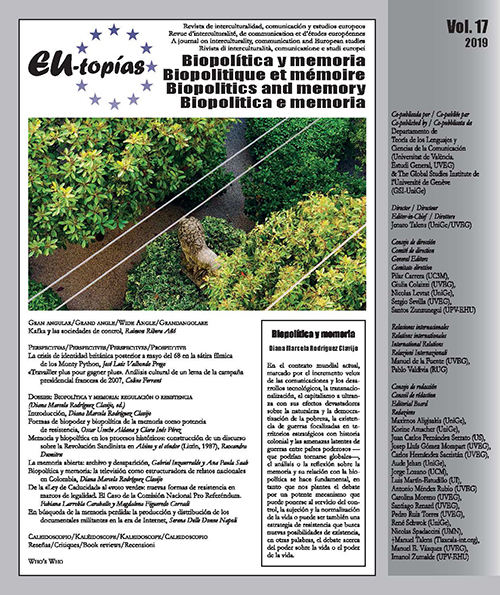Open memory: file and disappearance
DOI:
https://doi.org/10.7203/eutopias.0.18323Keywords:
Practices of memory, disappearance, photography, archive, politics, Mothers of Plaza de Mayo Abstract
Abstract
The article explores the construction of memory practices in the context of Argentinean dictatorship and post-dictatorship. The photograph of a disappeared detainee, as a probative document of an existence, formed the basis of an archive at the beginning involuntary, improvised, artisanal, which grew and became more complex until it became a genuine counter-archive against the State’s narrative during and after the dictatorship. These first archival practices, marked by urgency and uncertainty, helped to shape a symbolic universe in which to hold the trace of the absent. The figure of disappearance fixed on the photographic medium evoked a fundamental disagreement amidst the pretensions of democratic reconstitution in post-dictatorship; it would also lay the foundations for practices of memory intensely linked to forms of cultural and political resistance still in force in Argentina.
 Downloads
Downloads
 References
References
AGAMBEN, Giorgio (2006), Homo Sacer. El poder soberano y la nuda vida. Valencia: Pre-textos.
— (1998), Lo que resta de Auswichtz. Ciudad Autónoma de Buenos Aires: Adriana Hidalgo editora, 2017.
ALPHEN, Ernst van (2018), Failed Images. Photography and Its Counter-Practices. Amsterdam: Valiz.
–– (2017), Escenificar el archivo. Arte y fotografía en la era de los nuevos medios. España: Ediciones Universidad Salamanca.
BENJAMIN, Walter (1989), «La obra de arte en la época de la reproductibilidad técnica», en Discursos interrumpidos I. Buenos Aires: Taurus [1936].
CALVEIRO, Pilar (1995), Poder y desaparición. Buenos Aires: Colihue.
CRENZEL, Emilio (2010), «Políticas de la memoria en Argentina. La historia del informe Nunca más». En Papeles del CEIC, vol. 2010/2, n.o 61, CEIC (Centro de Estudios sobre la Identidad Colectiva), Universidad del País Vasco, http://www.identidadcolectiva. es/pdf/61.pdf.
DA SILVA CATELA, Ludmila (2011), Re-velar el horror. Fo- tografía, archivos y memoria frente a la desaparición de perso- nas. Documento de trabajo.
DEOTTE, Jean-Louis (2004), «Las paradojas del Acon- tecimiento de una desaparición». En Belay Raynald, Bracamonte Jorge, Degregori, Carlos y Vacher Jean, Memorias en conflicto. Aspectos de la violencia política con- temporánea. Institut français d’études andines, Insti- tuto.
— (2013), La época de los aparatos. Buenos Aires: Adriana Hidalgo Editora.
DIDI-HUBERMAN, Georges (2014), Pueblos expuestos, pueblos figurantes. Buenos Aires: Manantial.
FOUCAULT, Michael (2002), La arqueología del saber. Buenos Aires-México: Siglo XXI.
JELIN, Elizabeth (2018), La lucha por el pasado. Cómo construimos la memoria social. Buenos Aires: Siglo XXI.
KRACAUER, Siegfried (2008), La fotografía y otros ensayos. Barcelona: Gedisa.
LAMPASONA, Julieta (2013), «Desaparición forzada en Argentina: entre la desaparición y la sobrevida. O sobre la ‘regla’ y la ‘excepción’ en el despliegue de la tecnología de poder genocida», Aletheia, volumen 3, número 6, 2013.
LARRAQUY, Marcelo (2013), Los 70. Una historia violenta. Buenos Aires: Aguilar.
LONGONI, Adriana (2010), «Arte y Política. Políticas visuales del movimiento de derechos humanos desde la última dictadura: fotos, siluetas y escraches», Aletheia, volumen 1, número 1.
NANCY, Jean Luc (1996), Ser singular plural. Madrid: Arena. RANCIERE, Jacques (2011), El tiempo de la igualdad. Barcelona: Herder.
RICHARDS, Nelly (2000), Políticas y estéticas de la memoria. Chile: Editorial Cuarto Propio.
LVOVICH, Daniel y Bisquert, Jaquelina (2008), La cambiante memoria de la dictadura: discursos públicos, movi- mientos sociales y legitimidad democrática. Buenos Aires: Biblioteca Nacional, Los Polvorines: Univ. Nacional de General Sarmiento.
Downloads
Published
How to Cite
-
Abstract301
-
PDF (Español)85
Issue
Section
License
![]()
The authors conserve the copyright. All content published in EU-topías. Journal of interculturality, Communication, and European Studies are subject to the license Creative Commons Attribution-NonCommercial-ShareAlike 4.0 license. The full text of the license can be found at <http://creativecommons.org/licenses/by-nc-sa/4.0>
They may be copied, used, disseminated, transmitted and publicly displayed, provided that:
- The authorship and original source of the publication is cited (journal, publisher and URL of the work).
- They are not used for commercial purposes.
- The existence and specifications of this license of use are mentioned.
It is the responsibility of the authors to obtain the necessary permissions for images that are subject to copyright.



